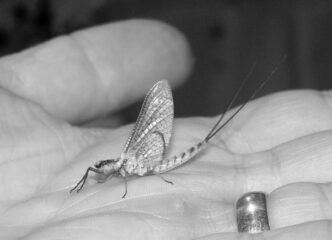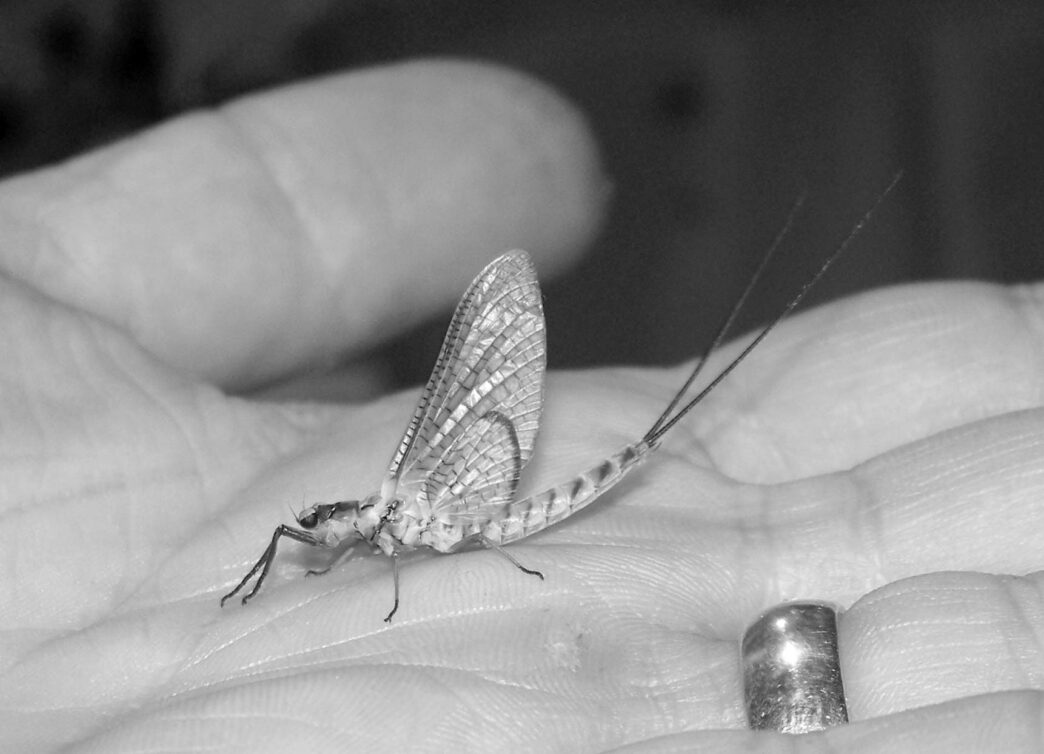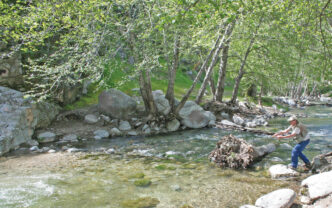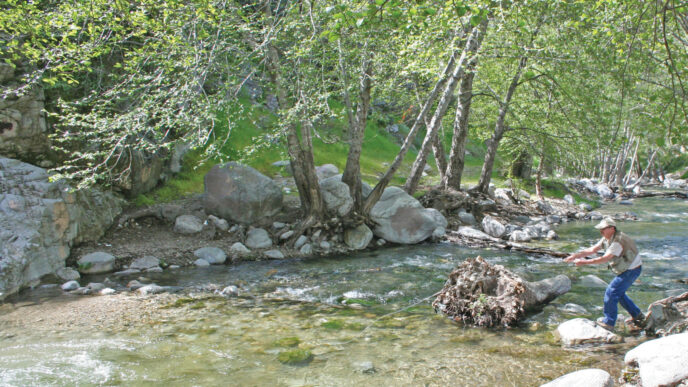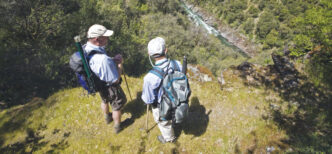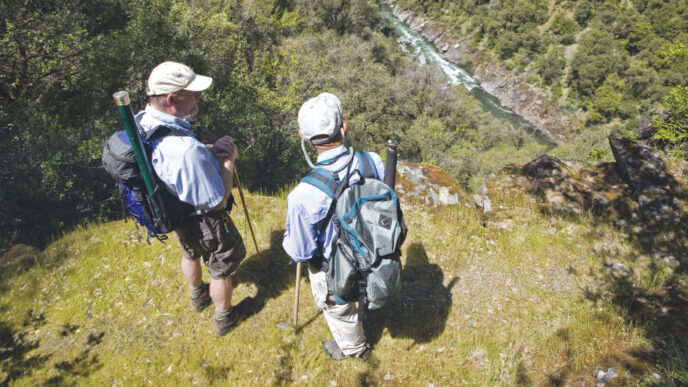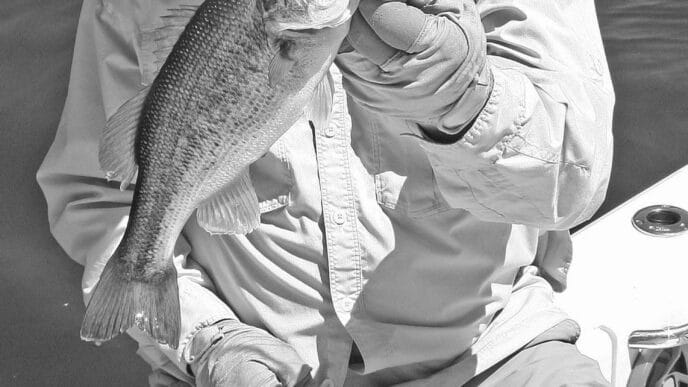One June evening, while I was locking the front door to a fly shop in Chico, a pickup truck screeched to a stop in front of me. Blue smoke billowed into the air, and the engine smelled like it had just run the Daytona 500. The driver’s door flew open and an older fellow jumped out, exclaiming, “I was at the lake last night and the hatch was on. I need some Hexes!” I calmly unlocked the door, and as the angler hurried toward the fly bins he grinned at me and said, “I’ll take them all.” That was years ago, but anglers still go crazy for the Hex hatch on Lake Almanor. I’m talking about Hexagenia limbata, the big — really big —yellow mayfly.
The Lake Almanor area is rich in history. The California Maidu Indian tribe named the lake site “oy-ding-koyo” or Big Meadows. The Maidu called Big Meadows home for centuries. In the 1840s, pioneers traveling west on the Emigrant Trail settled in the meadow. Stories of gold circulated, and the population grew rapidly. Then, in 1901, Julius Howells visited the area. Howells envisioned a reservoir and hydropower plant in the meadow to generate electricity for the growing Sacramento Valley region. On Howells’s return to San Francisco, he met with two brothers who showed an interest in investing in the project. Edwin and Guy C. Earl financed the venture and formed the Western Power Company. In 1914, the first dam was completed. The reservoir was named “Almanor” by Guy C. Earl after his three daughters: Alice, Martha and Elinor. The Western Power Company grew into the Great Western Power Company, which eventually was acquired by Pacific Gas & Electric, which operates the lake today. The original dam was replaced 1926–27. That replacement dam is named Canyon Dam. Lake Almanor is 13 miles long and 6 miles wide, roughly 52 square miles of beautiful water, and it stores 1.3 million acre-feet of water.
Hatch Characteristics
The Hexagenia hatch happens on the west side of Lake Almanor. The west side of the lake is shallower than the east side, simply due to the fact that the west side was Big Meadows. The east side is mostly rock, with that part of the lake sitting in a canyon. The west side stretches from Canyon Dam, at the south end of the lake, to Goose Bay at the north. The majority of the Hex hatch happens between Canyon Dam and the community of Almanor West. The majority of the angling is conducted at what’s known as “Geritol Cove” at Canyon Dam or in the area of the Plumas Pines Resort.
Hexagenia nymphs burrow half-moon-shaped tunnels into the mud floor. Throughout their life cycle, the nymphs leave the burrows to molt and grow, then return back to their burrows until they are mature. Once the nymphs are mature, they start to swim to the surface of the lake to hatch. Hexagenia nymphs thus are available to the fish for food all year long, but only in late June and early July do the fish migrate to the west side of Almanor to gorge themselves on the hatching Hexes. Smallmouth bass, rainbows, brown trout, and landlocked salmon all enjoy the feast. When you fish the Hex hatch, you never know exactly what is going to grab your fly.
Tactics and Tackle
For the best success, anglers fishing the Hex hatch on Lake Almanor must fish from a boat, pram, pontoon boat, or float tube. The choice of many guides, me included, is a pontoon boat. The primary benefits of a pontoon boat are twofold: they are easier to launch than boats (almost any beach will do), and they provide greater mobility when compared to float tubes.
Any 9-foot rod for a 4-to-6-weight line will work quite well. However, you should bring two rods — one rigged with a floating line and one for a sinking line (I like a clear intermediate line for the latter). You also need quality reels with good drag systems. Lake Almanor’s Hex-chasing fish are measured in pounds, not inches.
The Hexagenia nymphs start the slow migration to the surface early in the day. As you might expect, nymphs in deeper water take longer to reach the surface than nymphs in shallower water, so to hatch in the evening, they have to start earlier. The surface hatch commonly happens right at sundown, when when the Hexes start to appear on the water like popcorn. It is amazing emergence. This timing dictates when and where you should fish.
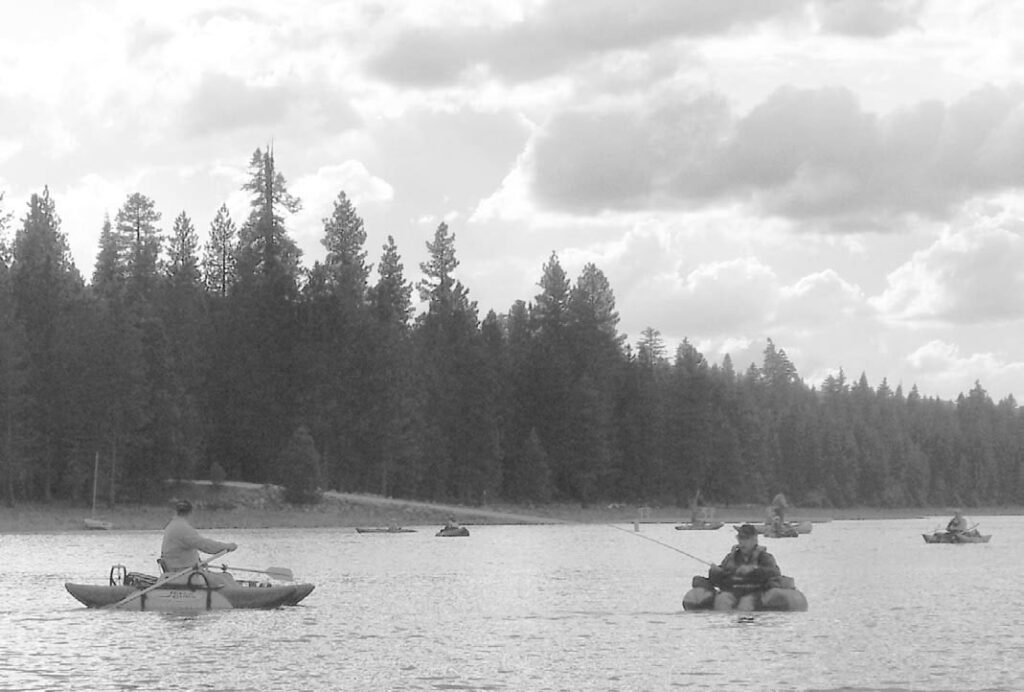
Start to fish the hatch around 4 to 6 P.M. in deeper water, 20 to 25 feet deep, with a sinking line and a 7-1/2 foot 3X leader. Work the water column by using the countdown method until you find fish. This is easy to do if you know the sink rate of your line. After you cast, simply count the seconds. For example, if you’re fishing an intermediate line with a two-inch-per-second sink rate, then a count of 20 seconds will mean your fly is at the 40-inch depth. When you reach the depth you want, start the retrieve.
As the sun starts to set, move closer to the bank, into water 10 to 15 feet deep. Work the sinking-line setup in the top 5 feet of the water column or until you start getting hookups, and continue to fish the sinking line until the fish start to show activity on the surface.
Once the mayflies start to pop out on the surface, the sinking-line setup will continue to produce fish, but I usually switch to the floating line. There is nothing better than taking a big fish on a dry fly. The fish become selective at times. When they do, adding life to the dry flies with a little twitch here and there will pay off quickly.
To maximize your chances for hookups, fish two flies that represent different life stages of the Hex. For example on sinking line, I fish a size 6 or 8 nymph imitation with a size 8 bugger pattern for the trailer. (See the sidebar for specific pattern recommendations.) A slow, slow, handover-hand retrieve, Jay Fair style, or small, three-to-four-inch strips works best. Strip, then pause, letting the fly drop in the water column. Letting the fly fall after the strips can result in jolting strikes.
On the floating line, I fish a size 6 paranymph pattern with a size 6 or 8 stillborn pattern as a trailer. The paranymph acts as an indicator for the stillborn, which sits slightly under the surface. A useful tactic is to “twitch and sit” the flies. As soon as they hit the water, give them a twitch, then let them sit motionless. Then give the line a slight twitch again — just enough to make the flies move. Let them sit again and repeat the process. The fish usually strike as soon as you make a twitch.
When fishing the Hex hatch on Lake Almanor, anglers should strive to be able to match all stages of the Hexagenia life cycle. Nymphs, paranymphs, stillborns, cripples, and paradrake dry flies all have value. While the sequence I’ve outlined is generally the best way to angle, at any time the fish can be keying on one stage of the cycle. Anglers who can adapt are the ones who will catch fish.
Fishing the Hex hatch late in the evening on Lake Almanor, the angler must be prepared for anything. Two years ago, while I was guiding the lake, we had a severe thunderstorm, and the wind came up very quickly. The lake turned to whitecaps rapidly, and I had my clients beach their boats a quarter of a mile down the shoreline from the launch area for safety. Wearing personal floatation devices is a necessity. I fish from a pontoon boat, so I have both oars and fins. I recommend you use tethers on your fins and oars. There is nothing worse than losing a fin or an oar. I pack a rain jacket with a hood, plenty of water, snacks, and two lights.
Having lights is very important. Normally during the Hex hatch, it’s common not to get off the water until around 10 P.M. You need light that’s on intermittently so you can see what you are doing — tying on flies, releasing fish, or simply securing your rods so you can head in. But you also need another light that’s on constantly so others can see you.

Tying Gray’s TS 2 BH Bugger Hex
Lincoln Gray’s TS 2 BH Bugger Hex is a very simple and effective fly to fish. Here is how you tie it.
Hook: Daiichi 1710, size 8
Bead: 1/8-inch gold bead
Thread: Olive 140 Ultra Thread
Tail: Golden yellow J. Fair grizzly marabou
Hackle: Golden yellow J. Fair saddle hackle
Body: Glimmer medium olive J. Fair Short Shuck
Thorax: Glimmer medium olive J. Fair Long Shuck
Place the bead on the hook and secure the hook in the vise. Start the thread behind the bead and wrap it to the bend of the hook. Tie in a grizzly marabou tail the length of the hook shank. Tie in the saddle hackle and the Short Shuck at the bend of the hook. Wrap the Short Shuck forward to the three-quarter point of the shank. Tie off the Short Shuck and tie in the Long Shuck. Wrap the Long Shuck forward to the bead. Tie off the Long Shuck and palmer the hackle forward to the bead. Tie off the hackle behind the bead, whip finish, and cement the head. The fly is complete. This fly can be tied in a variety of colors by changing the marabou, hackle, and J. Fair shuck.
Lake Almanor Fly Patterns
The author of this article guides on Lake Almanor, and, like guides everywhere, over time has developed strong preferences for fly patterns. Lance particularly recommends Gray’s Hexagenia Nymph, Burk’s Hexagenia Nymph, Mercer’s Rag Hex Nymph, Gray’s TS 2 BH Bugger Hex, Gray’s Hexagenia Stillborn, Milt’s Hexagenia Paranymph, Quigley’s Emerging Hex Nymph, the Loco Hex (paradrake), Doctor Dale’s Almanor Special, and Milt’s Hexagenia Paradrake. Some of these patterns are available through retailers, and tying instructions for several can be found on the Web by using your favorite search engine.
Recipes for other time-tested Hexagenia patterns, although not designed specifically for Lake Almanor, have been published in a number of fly-tying manuals, such as Randall Kaufmann’s Tying Dry Flies (Western Fisherman’s Press, 1991). Try experimenting. I’ve found the common olive Woolly Bugger to be an effective subsurface imitation during the Fall River’s Hexagenia hatch; perhaps it’ll work at Lake Almanor, too.
Richard Anderson
If You Go . . .
Lake Almanor is very easy to find. Highway 89 runs right along the west side of the lake. From Sacramento, go north on Interstate 5 to the Highway 99/70 exit. Go north on Highway 99/70 until it splits. Stay on Highway 70 toward Quincy, and at the intersection of Highway 89, turn north. Continue on Highway 89 until you cross Canyon Dam. Take a right off Highway 89 to the boat launch area. Geritol Cove will be in front of you.
From the San Francisco Bay Area, take Interstate 80 to Sacramento and follow the above directions. If you prefer to travel I-5, drive to Red Bluff and take Highway 36 east. Highway 36 and Highway 89 become the same highway for several miles. Continue on Highway 36/89 to the intersection of Highway 36 and Highway 89 south. You will be at the north end of the west side of Lake Almanor. Travel roughly four miles south to Almanor West and the Plumas Pines Resort area. Before you go, it is always wise to get up-to-date road and fishing information.
Lake Almanor has one fly shop: The Lake Almanor Fly Fishing Company, located in Chester at 181 Main Street #1; phone (530) 258-3944, e-mail flyfishing@frontiernet.net, on the Web at www.almanorflyfishing.com. Flies and advice are also available at Ayoob’s Sports at 201 Main Street in Chester. The next closest fly shops are in Chico: the Sierra Stream Fly Shop at 847 West 5th Street, phone (530) 345-4261, on the Web at www.sierrastreamflyshop.com; the Chico Fly Shop, 1154 W. 8th Avenue, (530) 345-9983, on the Web at www.chicoflyshop.com; and Fish First!, 766 Mangrove Avenue, (530) 343-8300.
Guide services specializing in Lake Almanor are available through The Lake Almanor Fly Fishing Company (information above); Stillwater Fly Fishing Adventures, www.stillwaterflyfishingadventures.com, (530) 520-6895; and Lance Gray and Company, www.lancegrayandcompany.com, (530) 517-2204.
Lance Gray



